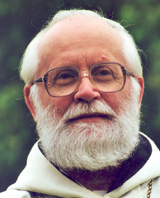 |
|
||
|
|
|||
January
12, 2014 - Baptism of the Lord –A
Monastery
of Illah, Delta State, Nigeria
H O M I L Y
When we are on a
journey, the most important moments are when we come to some crossroads. These are the places where the most
consequential decisions about our future have to be taken;
the times when it becomes more crucial to know where we want to go and where we
are actually going.
In the Gospel we
just heard, two persons are in presence, Jesus and John the Baptist, and they
find themselves at a crossroad ‑‑ in more than one sense of the
word.
Geographically, first! The place where they meet, along the Jordan,
near Jericho, is the lowest point on earth, a few hundred feet under see level.
It is the site where both the road from Jerusalem and the road from Galilee
die. It leads nowhere!
Spiritually also, the location is a
crossroads. Nearby is the monastic settlement of Qumran: a sect that broke away
from the Temple liturgy of Israel, lives on the margin of the People of Israel,
waiting for a Master of Justice that will re‑establish the Kingdom of
David and the legitimate liturgy in the Temple, nurturing a Tradition that
leads nowhere.
Personally, the two characters in
presence, John and Jesus, have much in common, and in the same line...
John the Baptist is a drop out. He was from a priestly family. From his birth,
he was destined to serve in the Temple. At some point in his life, he rejected his priestly service; he refused
to become a rabbi. Instead, he took the way of the desert. A path that led nowhere. There, in the
wilderness where there was no way, the Way came to him.
Jesus himself is at a crossroads. He grew up in a traditional Jewish family, in
the conservative Galilee of the Northern Kingdom. He received his religious
formation at the local Synagogue and used to make the annual pilgrimage to the
Jerusalem Temple with his parents. Then, suddenly, around the age of thirty, he
leaves Galilee, he breaks away from his family (who thinks he has got mad and,
at some point, try to bring him back home). He also takes the road leading to the desert and he is
baptized by John.
The path He took
also led nowhere. But,
by doing so He was going to bring human beings to themselves. Listening to the Voice of the Father
thundering in the silence of that nowhere, he discovered the Way in his
heart. He received the revelation that
He was the Way. From that time on,
everything was radically changed: for Him, for us, for all.
Most people enter
history walking backwards, looking at their past. The myth of the lost paradise
and the aspiration to return to it has plagued all the religions throughout
centuries. To look forward is more
daring and challenging. To face history
looking forward, towards something that, in relationship to time, does not exist
yet, but that, in relationship to eternity, already determines our identity.
Jesus and John,
both, are marching towards their future looking straight ahead.
The Blood of
Christ in which we were baptized and which we will
receive in this Eucharist is the still point where all the roads die. It is also the place where, in our personal
encounter with Jesus, we can be, like Him, covered by the Spirit, and where we
can hear the voice of the Father telling us once more that we are his sons.
And whatever has
been the journey that led us there, whether with its joys or its sorrows,
whether with grace or with wounds, whether in a direct flight or a laborious
wandering, that is the encounter that can free us from all the rest and give
meaning both to our present and our future. For this with give thanks in this Eucharist.
Armand VEILLEUX |
|
||
|
|
|||
